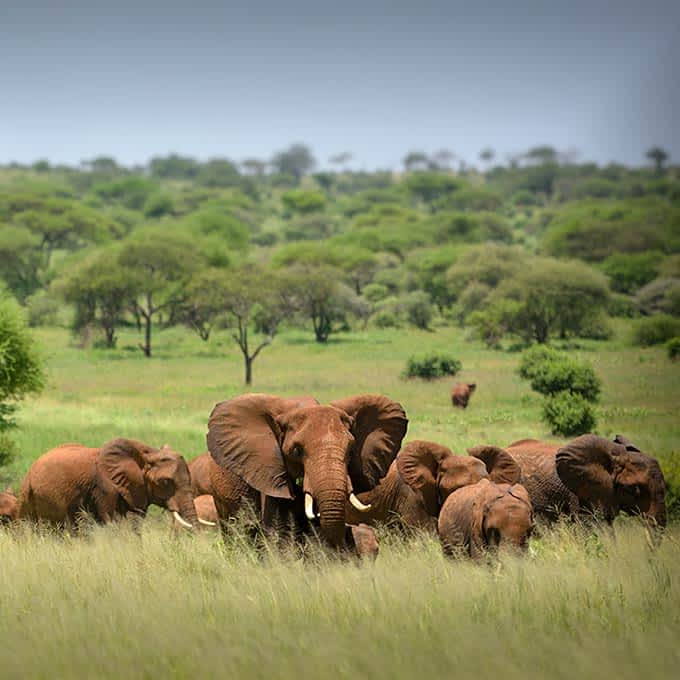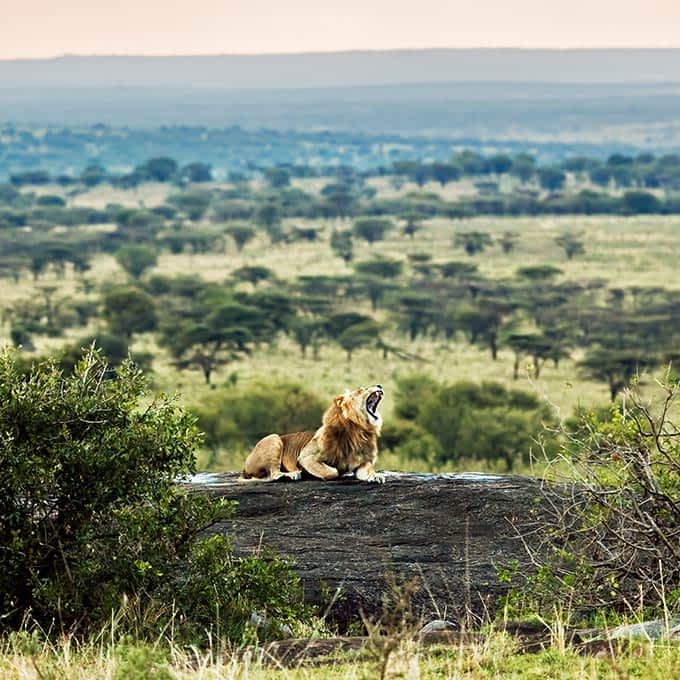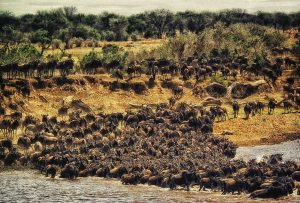Welcome to the Serengeti National Park—a place where the wonders of nature unfold before your eyes. Located in Tanzania, it’s famed for its expansive grasslands, breathtaking savannahs, and an impressive array of wildlife, including the iconic Great Wildebeest Migration. Also known as ‘the land that moves on forever’ in the Maa language, this destination promises an unforgettable safari experience. Picture herds of wildebeest, zebra, and antelope journeying through the landscape, with predators like lions and crocodiles close on their heels. Whether you choose a mobile camp to witness the action up close or prefer a quieter, more secluded escape, the Serengeti offers something for every type of traveler. Enjoy a personalized safari that caters to your interests, from private romantic camps to family-friendly lodges, and even a variety of activities like mountain biking and horse riding. Come and experience the magic of the Serengeti yourself.
## Exploring Serengeti National Park: Wildlife Haven

Credits: serengeti.com
Serengeti National Park, located in northern Tanzania, is one of the most **iconic wildlife destinations** in the world. Easily accessible from the nearest major city, Arusha, visitors can reach the park by road or air. Spanning approximately 14,750 square kilometers, the park’s vast landscapes include savannas, woodlands, and riverine forests, providing a perfect backdrop for its rich biodiversity.
Home to over 500 bird species and 70 large mammal species, Serengeti is a haven for wildlife enthusiasts. The park is renowned for housing the **Big Five**: lions, leopards, elephants, buffaloes, and rhinos, offering visitors unparalleled opportunities to witness these majestic animals in their natural habitat. Established in 1951, Serengeti is one of Tanzania’s oldest national parks and has earned recognition as a **UNESCO World Heritage Site** due to its significant role in conservation.
The park experiences a tropical climate, with a distinct wet and dry season. The ideal time to visit is during the dry season, from June to October, when wildlife is more easily spotted around water sources. Accommodations in the park cater to a variety of preferences and budgets, ranging from luxury lodges and tented camps to budget-friendly campsites.
Visitors to Serengeti can engage in a range of activities designed to immerse them in the park’s natural beauty. Popular options include game drives, hot air balloon safaris offering aerial views of the landscape, guided walking tours, and cultural visits to Maasai villages. These activities provide a deeper understanding of the park’s ecosystem, which supports a complex web of life involving predators, herbivores, and diverse plant species.
In addition to being a premier safari destination, Serengeti National Park is a hub for scientific research and offers educational programs for visitors. The park’s visitor facilities include centers equipped with informative displays, picnic sites, and detailed maps to enhance the overall safari experience. Whether you’re a seasoned traveler or a first-time visitor, Serengeti promises an unforgettable adventure in one of the world’s most cherished wildlife havens.
## The Great Wildebeest Migration: Nature’s Spectacle

Credits: oryxphoto.com
The Great Wildebeest Migration is one of the most **awe-inspiring natural events** on the planet. Over 1.5 million wildebeest, joined by hundreds of thousands of zebras and gazelles, embark on a year-long journey across the Serengeti and Maasai Mara. This cyclical migration is driven by the search for fresh grazing, following the patterns of rainfall.
Between January and March, the southern Serengeti becomes a birthing ground as over 500,000 calves are born. This **calving season is not only** a time of renewal but also a period of vulnerability, attracting predators like lions, cheetahs, and hyenas. The sight of a predator on the hunt provides some of the best wildlife viewing opportunities.
One of the most **dramatic moments of the migration** is the Grumeti River crossing. Here, the wildebeest face numerous challenges, including strong currents and lurking crocodiles. Similarly, the Mara River crossings between July and September are perilous, with predators waiting to take advantage of the chaos. These crossings are a photographer’s dream, offering dramatic scenes best captured in the early morning or late afternoon light.
However, the migration is not without its challenges. Poaching and habitat fragmentation threaten this delicate ecosystem. Conservation efforts are crucial to ensure the survival of this incredible phenomenon. Despite these challenges, the migration continues to attract thousands of tourists each year, significantly contributing to the local economy through tourism.
For those seeking to witness this spectacle, guided safaris offer an enriching experience. Expert guides provide valuable insights and ensure safe encounters with wildlife, enhancing the overall experience. Whether you’re a seasoned photographer or a nature enthusiast, the Great Wildebeest Migration is an unforgettable adventure.
## Year-round Wildlife Viewing in Serengeti

Credits: serengeti.com
The Serengeti offers **exceptional wildlife viewing opportunities** throughout the year, each season bringing unique experiences. During the dry season, from June to October, animals congregate around water sources, making it an ideal time for game viewing. You can witness large herds of wildebeest, zebras, and gazelles, as well as predators like lions, leopards, and cheetahs, which are more easily spotted in the sparse vegetation.
The green season, spanning November to May, transforms the Serengeti into a lush paradise. This period is perfect for bird watching, with over 500 bird species, including migratory birds, making their appearance. It’s also the time when many animals give birth, offering the **chance to see adorable newborns** and the predators that follow them.
Predator sightings are a year-round highlight in the Serengeti. Lions, leopards, and cheetahs are commonly seen, but sightings peak during the dry season when these predators are more active. For bird enthusiasts, the wet season brings a vibrant display of avian life, from raptors to colorful bee-eaters.
Night safaris, available in certain areas, provide a thrilling opportunity to see nocturnal animals such as leopards, hyenas, and genets. These night drives reveal a different side of the Serengeti, one that’s teeming with activity long after the sun has set.
Hot air balloon safaris offer a **unique perspective of the Serengeti**’s vast landscapes and diverse wildlife. Available year-round, these flights provide a breathtaking view of the park’s plains, kopjes, and riverine areas, making it a must-do activity for visitors.
For a more intimate experience with nature, walking safaris led by armed guides are available in select areas. These walks allow you to get up close to the flora and fauna, providing a deeper connection to the environment. Additionally, Maasai cultural tours are offered throughout the year, giving insights into the traditional lifestyle of the Maasai people and their symbiotic relationship with the land.
The Serengeti’s diverse terrain, including open plains, rocky kopjes, and lush riverine areas, provides endless photographic opportunities. Whether capturing the dramatic predator-prey interactions or the serene beauty of a sunrise over the savannah, photographers will find no shortage of subjects in this iconic park.
Dry Season (June to October): Ideal for game viewing as animals congregate around water sources.
Green Season (November to May): The landscape is lush, and it’s a great time for bird watching and seeing newborn animals.
Predator Sightings: Lions, leopards, and cheetahs can be seen year-round, with higher chances during the dry season.
Bird Watching: Over 500 bird species can be spotted, with migratory birds arriving during the wet season.
Night Safaris: Some areas offer night drives to see nocturnal animals like leopards, hyenas, and genets.
Hot Air Balloon Safaris: Available year-round, providing a unique perspective of the park and its wildlife.
Walking Safaris: Led by armed guides, these safaris offer an intimate experience with nature and are available in select areas.
Maasai Cultural Tours: Available throughout the year, offering insights into the traditional lifestyle of the Maasai people.
Scenic Landscapes: The park’s diverse terrain includes plains, kopjes, and riverine areas, each offering unique wildlife viewing opportunities.
Photographic Opportunities: The park’s varied landscapes and abundant wildlife provide endless possibilities for photography enthusiasts.
## Diverse Safari Options for Every Traveler
The Serengeti offers a wide range of safari experiences tailored to meet the needs of every traveler. For those seeking a high-end adventure, luxury safaris provide a premium experience with stays in top-notch lodges and camps. These all-inclusive packages often feature gourmet dining and exclusive game drives, ensuring a lavish and comfortable journey through the wild.
For the budget-conscious adventurer, **affordable camping safaris offer** a chance to experience the Serengeti without breaking the bank. These trips include basic amenities and shared game drives, making the wilderness accessible to everyone.
Families looking for a memorable adventure will find family safaris ideal. These itineraries are crafted with **family-friendly accommodations and activities** that cater to children, ensuring a fun and educational experience for all ages.
Couples can enjoy romantic escapades with honeymoon safaris. These packages include stays in secluded lodges, intimate dinners, and special activities designed for two, creating unforgettable memories in a breathtaking setting.
Photographic safaris are perfect for those keen on capturing the Serengeti’s beauty through a lens. Guided by professional photographers, these tours focus on getting the best shots of the wildlife and landscapes.
Walking safaris offer a unique way to explore the Serengeti on foot. Guided walks allow visitors to get close to nature and experience the park’s flora and fauna in an intimate setting.
For a bird’s-eye view of the Serengeti, balloon safaris provide an unforgettable experience. Hot air balloon rides offer stunning aerial perspectives of the landscape and its inhabitants.
Experienced travelers who prefer a more flexible itinerary can opt for self-drive safaris. This option allows them to explore the park at their own pace, discovering the Serengeti on their terms.
Cultural safaris provide a deeper understanding of the local heritage. These tours include visits to Maasai villages and other cultural experiences, offering a glimpse into the rich traditions of the region.
Special interest safaris cater to niche passions such as bird watching, botany, or geology. These customized tours ensure that enthusiasts can delve deeply into their specific areas of interest while exploring the Serengeti.
| Safari Type | Description |
|---|---|
| Luxury Safaris | High-end lodges and camps offering all-inclusive experiences with gourmet dining and private game drives. |
| Budget Safaris | Affordable camping safaris that provide basic amenities and shared game drives. |
| Family Safaris | Tailored itineraries with family-friendly accommodations and activities suitable for children. |
| Honeymoon Safaris | Romantic packages that include secluded lodges, private dinners, and special activities for couples. |
| Photographic Safaris | Guided tours focused on wildlife photography with professional photographers. |
| Walking Safaris | Guided walks that allow visitors to explore the park on foot and get close to nature. |
| Balloon Safaris | Hot air balloon rides offering aerial views of the Serengeti and its wildlife. |
| Self-drive Safaris | Options for experienced travelers who prefer to explore the park at their own pace. |
| Cultural Safaris | Tours that include visits to local Maasai villages and cultural experiences. |
| Special Interest Safaris | Customized tours focusing on specific interests such as bird watching, botany, or geology. |
## Frequently Asked Questions
#### 1. What kind of animals can I expect to see on a Serengeti safari?
You can expect to see a wide variety of animals, including lions, elephants, leopards, and buffalo. The Serengeti is also famous for the Great Migration, where millions of wildebeest and zebras move across the plains.
#### 2. Can the safari experience be customized based on my interests?
Yes, you can personalize your safari experience to focus on what interests you the most, whether it’s certain wildlife, photography, or visiting specific areas of the Serengeti.
#### 3. What is the best time of year to visit the Serengeti?
The best time to visit depends on what you want to see. June to October is great for game viewing, while the Great Migration is best seen from December to July.
#### 4. Are safaris safe for families with children?
Yes, safaris can be very safe for families with children. Many tour operators offer family-friendly options and ensure that safety measures are in place.
#### 5. What should I pack for a safari in the Serengeti?
You should pack light, comfortable clothing in neutral colors, a hat, sunscreen, binoculars, and a good camera. Don’t forget essential items like medications and personal hygiene products.
TL;DR “Serengeti: Personalized Safari Experiences” covers the rich biodiversity and diverse landscapes of Serengeti National Park, renowned for the Great Wildebeest Migration and year-round wildlife viewing. The blog highlights the park’s history, climate, and accommodations, while offering an array of safari options such as game drives, hot air balloon rides, walking safaris, and Maasai cultural tours. It delves into specific experiences like luxury, budget, family, and honeymoon safaris. Key wildlife events, such as river crossings and calving season, are described, alongside photography tips and conservation efforts.






